By Eilene Lyon
While my Colorado Rocky Mountain home is fabulous, something about the Old World charm of the Swiss Alps has always called to me. We took this dream vacation in 2014. We flew into Zurich, visited Luzern, Lausanne, and Bern, but we spent the bulk of our trip in Lauterbrunnen. You will see why.
After landing in Zurich about 8 a.m., the second item on our agenda (after coffee), was to purchase a SwissRail pass for eight days. This is a must! Everything in Switzerland is expensive to an American, but a rail pass provides considerable savings. It covers much more than train travel. It is also good for trams, ferries, cable cars, buses, museums, and more. For transportation, we only had to pay a surcharge for the highest-altitude cable cars.

We made only one reservation in advance: a night in downtown Zurich. A room with bed, bath, and barely space to turn around cost €300. They did graciously allow us to have breakfast that morning (before our night’s stay), for a little extra charge.

The next day we arrived by train in Luzern. We stopped at the tourism office and found a spacious room for the night. After dropping our luggage, we took a (free!) boat trip across the lake to catch the funicular and train to the top of Mt. Rigi. Though overcast in the city, we enjoyed above-the-cloud views from the peak.

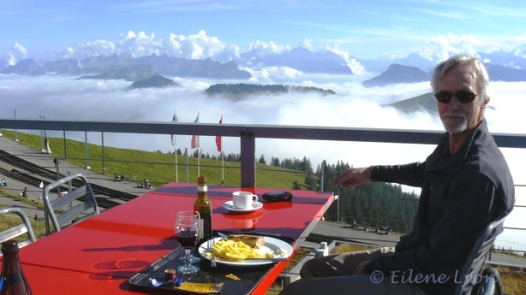
On to Interlaken, where we again visited the tourism office and arranged to stay in a furnished chalet apartment in Lauterbrunnen for four or five nights. It was lovely, but low doorways were a bit of a headache for The Putterer (at 6’ 2”).
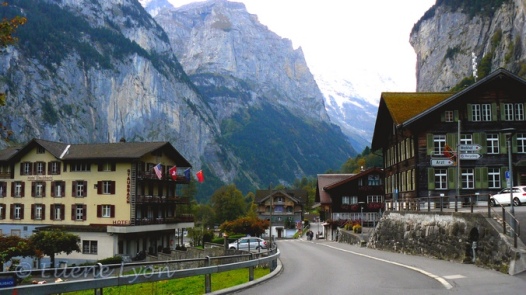
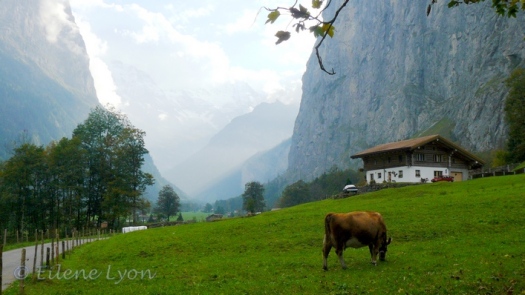
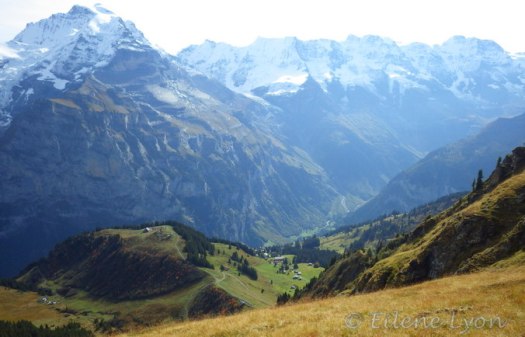






We rented bicycles in Lauterbrunnen one day and rode up valley to see the Trümmelbachfälle, which is a waterfall hidden in a cleft in the rocky cliffs that line the valley. It’s very difficult to get a photograph to do it justice. (Click images to enlarge)
We rode all the way down to Interlaken, then brought the bikes back to Lauterbrunnen by train.

Reluctantly, we parted from our temporary high-altitude home and took another train to Lake Geneva (also called Lac Léman; this body of water sits in both Switzerland and France). We found an incredible room in Montreux, right on the lake, with a balcony, for a very reasonable price.

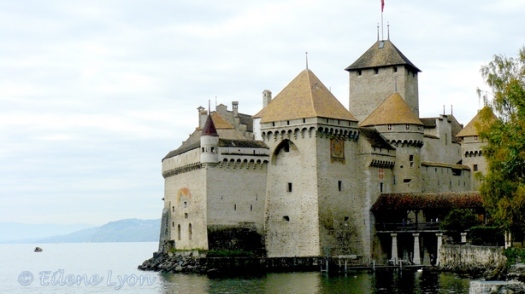
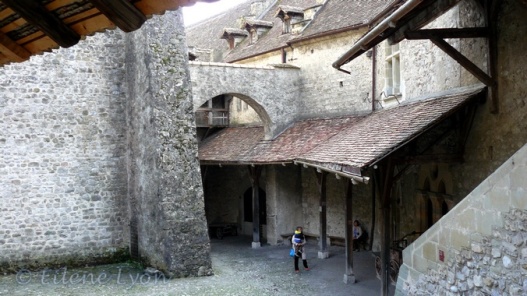
We spent the next day in Lausanne, walking around the city and visiting the Olympic Museum. Our last leg took us to Bern, the capital city. From there, it was off to the German portion of our trip—for another blog!

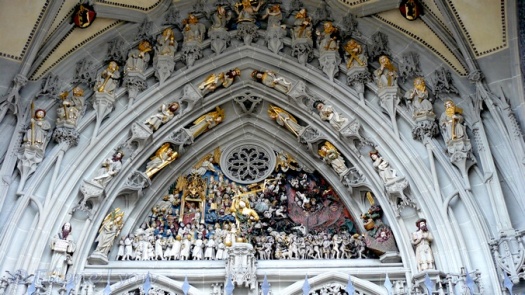
Feature image: View of the Eiger (left), Mönch, and Jungfrau peaks as seen from our hike down from Schilthorn. This is probably the most iconic view of the Swiss Alps.
Note: Technically, Heidi’s home was in the Maienfeld district in eastern Switzerland, not any of the areas we visited.



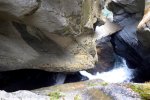
Beautiful
LikeLiked by 1 person
Very much so!
LikeLiked by 1 person
This really is a dream vacation. It seems so long ago when anyone I knew was traveling the world. Just going somewhere. I love the photos of the mountains. Just spectacular. Thanks for sharing this today, when the world outside my window is about as gray and wet as can be.
LikeLiked by 2 people
It’s looking that way here today, too. But back to sunshine very soon! Glad you enjoyed the Swiss scenery.
LikeLiked by 1 person
Beautiful photos, bringing back pleasant memories. My favorite places in Europe.
LikeLiked by 2 people
I would love to go back and spend more time exploring. Thanks for stopping by to check out the view.🙂
LikeLike
Thanks for sharing! I also feel the loss of trips like this. Maybe someday.
LikeLiked by 1 person
I sense that travel will be picking up again soon.
LikeLiked by 1 person
You are very brave to stay in Switzerland without hotel reservations. It is a beautiful country and easy to travel within. My great-great-grandfather came to the U.S. from Wolhuzen, Luzern. He worked in the train station. When there I imagined walking that covered bridge like he did. Love your pictures and story.
LikeLiked by 1 person
Thank you, Tonya. Zurich was a must to have a reservation. But October is sort of “off season” and we had no trouble finding lodging. In Montreux, the first place we went was full, but I asked if they knew of any vacancies and the clerk found us the room nearby.
LikeLike
so beautiful. Forever on my bucket list.
LikeLiked by 1 person
I hope you fulfill your wish!
LikeLiked by 1 person
What amazing scenes and architecture! And those cowbells. . .
LikeLiked by 1 person
I think the bells would drive me nuts if I had to listen to them all the time. I crave peace and quiet.
LikeLike
Wow! The scenery is spectacular. Thank you for posting the link to the cow bells article. I found it very interesting.
LikeLiked by 1 person
It really is incredibly beautiful being in the Swiss Alps. The bells…well, I would not want to be surrounded by them at all hours!
LikeLiked by 1 person
After listening to the bells clip, I have to agree!
LikeLiked by 1 person
22 seconds is tolerable!
LikeLiked by 1 person
But that’s the limit, eh?
LikeLiked by 1 person
Maybe a teensy bit longer…
LikeLiked by 1 person
😀
LikeLiked by 1 person
Superb. I haven’t been to Switzerland – yet.
LikeLiked by 1 person
Well you must get to it — if you like that sort of scene. 😉
LikeLiked by 1 person
What a magnificent place! That does look and sound like a dream vacation.
LikeLiked by 1 person
Lucky, the people who live there.
LikeLiked by 1 person
Yes they are! I’m a little envious but maybe it wouldn’t seem so special if it were that accessible.
LikeLiked by 1 person
I don’t know. I feel very lucky to live where I do. And having traveled widely, I do realize it’s special.
LikeLiked by 1 person
Reminds me so much of our own trip to Switzerland in 2018, especially since it looks like we visited some of the same places 🙂 How I hope to be able to travel to Europe again soon
LikeLiked by 1 person
I also look forward to future travels across “the pond”!
LikeLiked by 1 person
What a beautiful trip Eilene – the scenery is breathtaking there and how smart you were to get the Eurorail pass. You saw more that way. I’ve never been to Switzerland, but was in the Austrian Alps and traveled in Austria. Hearing the cow bells brought back memories. We stayed in a small chalet in the Alps. A husband and wife owned it; she managed the bed and board and he had cows which he walked past our rooms very early every morning to graze in the hills, etc. Their bells were clanging at each step they took. I brought home a small cow bell on a strap that was embroidered with Edelweiss which I hung on my car rear-view mirror for years. I was there in May 1979 and hiking through the wildflowers with my hiking stick was a wonderful and memorable experience.
LikeLiked by 1 person
Sounds like you had a wonderful experience. I wish we had done a little more hiking, which is why I would like to return to Lauterbrunnen or see other parts of the Alps. (Just to clarify, the SwissRail pass is only good in Switzerland and not part of the EurRail system – unfortunately!)
LikeLiked by 1 person
My father was there so language was no barrier and we traveled with his aunt and uncle who lived in Frankfurt and vacationed in Austria every year, so they were familiar with some smaller venues and sights along the way which was nice. I was mistaken about the pass, but I have always marveled when young folks got a EuRail pass and stayed in hostels to have a great European experience for less money. Your SwissRail pass was great in that it had encompassed various forms of transportation. Traveling in Toronto used to be like that – one fare gave you transfers to all over that City and you really didn’t need a car if you had good connections.
LikeLiked by 1 person
How wonderful to have had family there to help you around, determine what to see and do, and translate. Do you know much German?
LikeLiked by 1 person
Yes, it was lucky for us Eileen. Personally guided tour. My father had grown up in Frankfurt, but moved to Canada after WW II. His parents died when he was in his teens so he was close to this aunt and uncle. They spoke no German and neither do I (nor did my mom) so for my mom and me it was all about the scenery (and food). This aunt and uncle were in their late 70s or early 80s at the time. The uncle was retired – his livelihood had been a chef on a long-distance train.
LikeLiked by 1 person
Oh my, that’s quite a family history. How old was your father during the war, and what about his parents and siblings?
LikeLiked by 1 person
Yes – it is interesting. He was born in 1926, same as my mom. He met my mom in 1950 and told her he was an orphan. He didn’t talk about the war much Eilene, however he read a lot of books and saw movies about WWII and he built model dioramas about tanks in military settings as a hobby. He was in the German Army and he said he was very young when he began serving. He spoke more about being in the trenches and eating turnips (rutabagas) and potatoes for a steady diet. He told my mom his father died at the beginning of the war – I don’t know if he was a casualty of war. He never talked about his father and his mother died in a mental institution, also during the war and not a casualty of war. According to my father, she had a bad time going through menopause and “went out of her mind.” That’s what he told my mother.
I went to Germany in 1969 with my father. My maternal grandfather died in April 1969 and my grandmother came over to spend the Summer with us. My father had not been there since he left. I was 13 at the time. We went to the same places with the same aunt and uncle in 1969, as when we returned in 1979, that time with my mother. My father had no siblings and the aunt and uncle were the only relatives he had (to my knowledge).
After my father decided to leave my mother (Christmas Day 1983), he left the country and returned to Germany. I think I may have mentioned to you at one time he fled the country as he took money out of joint bank accounts and an annuity fund, claiming hardship and my mom could not sign the paperwork as she was out of the country. He got the money, then left. A friend of mine is very interested in tracing her roots and hired a genealogist in Germany to help her as she does not speak German. He finished the job relatively quickly and she had already paid him through PayPal so she asked me if I wanted to find out about my father. My friend had done my tree on my mom’s side awhile ago. The genealogist was able to track him down and at that time he was still alive and living in a very small town, had remarried (not divorced here though). The genealogist was very nice. He told me that death records appear as a notation on the birth records … not two separate records, a fact you likely know as you are so immersed in tracing your family roots?
LikeLiked by 1 person
It sounds like both your parents had challenging lives due to external circumstances. At least you had another opportunity to visit with him and the aunt and uncle. I know what you mean about the death notation on the birth records. I studied the old handwriting and how to read old records. I doubt they still do that today, except perhaps in small villages where records are kept in the churches. I don’t think civil records were ever kept that way. Churches even have books that record entire families for posterity.
LikeLiked by 1 person
I have a rather unusual family set of circumstances Eilene – that is for sure. Uwe Porten explained how they did the records and recommended that I follow a small village/town newsletter where my father lived to check if they mentioned his death. That newsletter mentioned birthdays and anniversaries and the like. He sent me a link to the newsletter, but since I don’t read/write or speak German, I could not easily decipher it. That is interesting how records are kept and information discovered when you know where to dig for them.
LikeLike
This looks like a dream vacation to me. I LOVE the photos and would love to visit. It stirs my imagination. And I was a huge Heidi lover. Didn’t she live somewhere close enough to Frankfurt? Was that the city she went to for awhile? I read that book at LEAST twice, maybe more times than that. Always wanted to play with the goats and eat bread and cheese! Hah.
LikeLiked by 1 person
I confess! Don’t know diddly about Heidi. 😳 Just knew she was an iconic Swiss girl. 😂 It really is an incredible place to visit – anyplace in the Alps would be, I’m sure. Hope you make it there someday.
LikeLike
Sometimes I think of rereading it yet again.
LikeLiked by 1 person
Just another deficiency in my reading history. I’m tackling “Jane Eyre” right now. Trying to get more classics in there. I read “Anne of Green Gables” not too long ago.
LikeLiked by 1 person
I love Jane Eyre! And even more, her novel, Villette. But Jane Eyre is a more important cornerstone of lit. Did you ever see the old Jane Eyre movie?
LikeLiked by 1 person
No, I am completely unfamiliar with all the Brontë works.
LikeLiked by 1 person
Beautiful photos! Marcus’s mother lives in Switzerland and he hasn’t visited her since before Covid, so he’s probably due in for a Swiss trip at some point in the near future (I still haven’t decided if I’m coming…we’ll see!). She’s moved from a chalet in the mountains to an apartment in the valley since we last visited, and though I’m sure it’s not quite as picturesque, it’s actually more of a selling point for me, as I didn’t relish climbing up three hundred icy, uneven steps to reach her chalet. That’s the trouble with mountains!
LikeLiked by 1 person
Icy steps would not be my choice, either! Cable cars and funiculars much better. If you haven’t been to Switzerland before, you should definitely go.
LikeLike
No, I’ve been a few times, hence my knowledge of the stair situation at the chalet. Just not in a while.
LikeLiked by 1 person
Beautiful! I’d love to go to Switzerland some day. I’ve taken a train through and flown over, but never set foot yet in the country.
LikeLiked by 1 person
I can’t imagine passing through on a train and not getting off to explore. There’s always another train coming along!😁
LikeLiked by 1 person
I was with a group traveling with the Experiment in International Living so I don’t think that would have gone over too well!
LikeLiked by 1 person
You could have said you were conducting an experiment.😉
LikeLiked by 1 person
LOL!!
LikeLiked by 1 person
What a delightful trip! Your photos are gorgeous, too.
LikeLiked by 1 person
Thank you!
LikeLike
Beautiful place! Yours photos are stunning.
LikeLike